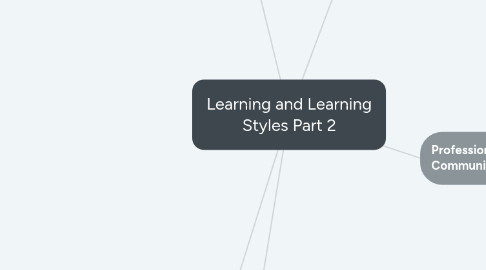
1. Multiple Intelligences (MI) Theory
1.1. Gardner's Defense and Exploration
1.1.1. Misconceptions
1.1.1.1. Tests
1.1.1.2. Intelligence = Domain/Discipline/Craft
1.1.1.3. Intelligence is the same as "Learning Style
1.1.1.4. Official Gardner/MI Approach
1.1.1.5. Not Based on Empirical Data
1.1.1.6. MI incompatible with hereditarian or environmental accounts
1.1.1.7. Too Broad
1.1.2. Based on eight explicit criteria
1.1.3. Intelligences are response to environment/ content in the world
1.1.4. Cannot assess intelligences
1.1.5. Theory must be tested in "the real world" not just "applied"
1.2. Critique of MI Theory
1.2.1. 5 Arguments for MI discounted
1.2.2. Lack of empirical evidence problematic
1.2.3. Cognitive Psychology and Neuroscience Not Exploring MI Theory
1.2.3.1. General Intelligence g theory
1.2.3.1.1. Overall brain efficiency: interconnection of mental skills/working memory
1.2.3.1.2. Does NOT exclude possibility of MI, but identifies issues in MI Theory
1.2.3.2. Multiple Information Processing Systems
1.2.3.2.1. Two large scale processing pathways
1.2.3.2.2. Cognitive skills share pathways
1.2.3.3. Adapted Cognition Models
1.2.3.3.1. Innate cognitive modules that generate adaptive behavior patterns
1.2.3.3.2. No evidence against, but argues that brain is unlikely to function via MI
2. Critique of Mozart Effect and Emotional Intelligence
2.1. Mozart Effect
2.1.1. Listen to Sonata, perform better on spatial skills test
2.1.2. Doesn't account for possible cortical arousal
2.1.3. Other possible sources (priming?)
2.1.4. No long term change in spatial IQ
2.1.5. Not consistently replicated
2.2. Emotional Intelligence
2.2.1. Multi-factor Emotional Intelligence Scale
2.2.2. Too many versions/constructs
2.2.3. Lack of empirical evidence
2.2.4. Conflicting constructs
2.2.5. Not Differentiated from Personality plus IQ
2.2.6. Real world success not validated
2.2.7. Alternative Theories
2.2.7.1. Multiple Socioemotional Skills
2.2.7.1.1. emotion and cognition intertwined mental function
2.2.7.1.2. multiple evolved brain adaptations
2.2.8. Unresolved issues with EI Theory
2.2.8.1. privately owned datatests
2.2.8.2. lack of supporting evidence in non-proprietary studies
3. Why MI, ME, EI popular and why that's a problem
3.1. Context
3.1.1. Fraud
3.1.2. Anxieties
3.1.3. Absent Evidence
3.1.4. Ignoring Evidence
3.2. Reasons
3.2.1. Credo Consolans: comfort, power, control
3.2.2. Immediate Gratification
3.2.3. Easy Explanation
3.3. Transmission of Ideas
3.3.1. Simply makes sense (confirmation bias)
3.3.2. Rewards:
3.3.2.1. effective teaching
3.3.2.2. easy to understand model
3.4. Folk Psychology: innate human disposition to find simple models appealing
3.5. Human Differences vs. Belief in Human Equality
3.5.1. G associated with inherently unequal meritocracy
3.5.2. Disparities in educational opportunities
3.6. Why Harmful?
3.6.1. Damage to epistemologies of learning process
3.6.2. When used, replace classroom practices with greater benefit
3.6.3. Damage to educational field that values ideas supported by preponderance of evidence
4. Constraints on Theories of Cognition
4.1. Shared overlapping pathways vs separate functions
4.2. role of effort and repetition in learning
4.3. narrow, unipurpose computational devices to address human problems not acconted for in MI, ME, EI
4.4. Constraints
4.5. narrow, unipurpose computational devices to address human problems not acconted for in MI, ME, EI
5. Multiple Intelligences Critique of Multiple Intelligences “G” Theory Multiple Information Processing Systems Adapted Cognition Theory ME Theory EI Theory Why is MI, ME, and EI theories so popular but harmful? Gendered learning PLC’s
6. Gendered Learning
6.1. The Minds of Boys- Gurian & Stevens
6.1.1. Mismatch between boys and conventional education
6.1.1.1. male nature/male brain plastic?
6.1.2. How gender happens in the brain
6.1.2.1. Chromosomes
6.1.2.2. hormone surges
6.1.2.3. cues to parents, community
6.1.3. "Myth of gender plasticity"
6.1.3.1. biological brain differences
6.1.3.2. educational system claims boys are deficient in some way
6.1.4. Argue that system trying to change boys, rather than adapting
6.1.5. propose "boy friendly model" for "protectin the minds of boys
6.1.5.1. Expression of natural self
6.1.5.2. compensation for disadvantage/fragility
6.1.6. claim schools have become more girl friendly at the detriment of boys
6.2. Gender Equity - Corbett, Hill, St. Rose
6.2.1. Girls success don't come at boys' expense
6.2.2. On average, both girls and boys performance has improved
6.2.3. Race and Family income disparities more prevalent
7. Professional Learning Communities (PLCs)
7.1. Low performance and morale - impetus for change in one district
7.2. "Ambitious Aims": goals for improving student achievement
7.3. Sharing Knowledge (collaborating)
7.3.1. training for staff/reluctant staff re-engaged
7.4. Support Structures
7.4.1. focus on needs of teams
7.5. Scheduled Dialogue
7.5.1. Site visits
7.5.2. Principal PLCs
7.6. Fixed Focus
7.6.1. staff training
7.6.2. limiting initiatives
7.7. Resulted in Turning Around Performance
7.8. Celebrating and Recognizing successes improved morale
8. Questions this section brought up for me
8.1. In considering "G" and the psychometrics used to test intelligence, what evidence is there that the tests are not bias in terms of race and opportunity gaps? Created by "gatekeepers" - traditionally white male? Is there current research about this?
8.1.1. "giftedness" and testing: universal screening in TN (66% Black Students Identified, up from 44%) significantly less in WA
8.1.2. Intelligence (IQ) testing vs. Aptitude testing (past research suggested that SAT and other aptitude tests might be bias)
